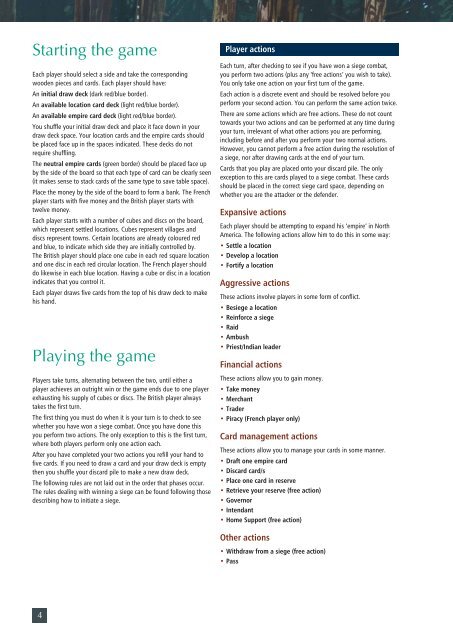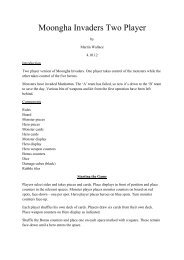A Few Acres Of Snow â 2nd Edition Rules (PDF) - Treefrog Games
A Few Acres Of Snow â 2nd Edition Rules (PDF) - Treefrog Games
A Few Acres Of Snow â 2nd Edition Rules (PDF) - Treefrog Games
You also want an ePaper? Increase the reach of your titles
YUMPU automatically turns print PDFs into web optimized ePapers that Google loves.
Starting the game<br />
Each player should select a side and take the corresponding<br />
wooden pieces and cards. Each player should have:<br />
An initial draw deck (dark red/blue border).<br />
An available location card deck (light red/blue border).<br />
An available empire card deck (light red/blue border).<br />
You shuffle your initial draw deck and place it face down in your<br />
draw deck space. Your location cards and the empire cards should<br />
be placed face up in the spaces indicated. These decks do not<br />
require shuffling.<br />
The neutral empire cards (green border) should be placed face up<br />
by the side of the board so that each type of card can be clearly seen<br />
(it makes sense to stack cards of the same type to save table space).<br />
Place the money by the side of the board to form a bank. The French<br />
player starts with five money and the British player starts with<br />
twelve money.<br />
Each player starts with a number of cubes and discs on the board,<br />
which represent settled locations. Cubes represent villages and<br />
discs represent towns. Certain locations are already coloured red<br />
and blue, to indicate which side they are initially controlled by.<br />
The British player should place one cube in each red square location<br />
and one disc in each red circular location. The French player should<br />
do likewise in each blue location. Having a cube or disc in a location<br />
indicates that you control it.<br />
Each player draws five cards from the top of his draw deck to make<br />
his hand.<br />
Playing the game<br />
Players take turns, alternating between the two, until either a<br />
player achieves an outright win or the game ends due to one player<br />
exhausting his supply of cubes or discs. The British player always<br />
takes the first turn.<br />
The first thing you must do when it is your turn is to check to see<br />
whether you have won a siege combat. Once you have done this<br />
you perform two actions. The only exception to this is the first turn,<br />
where both players perform only one action each.<br />
After you have completed your two actions you refill your hand to<br />
five cards. If you need to draw a card and your draw deck is empty<br />
then you shuffle your discard pile to make a new draw deck.<br />
The following rules are not laid out in the order that phases occur.<br />
The rules dealing with winning a siege can be found following those<br />
describing how to initiate a siege.<br />
Player actions<br />
Each turn, after checking to see if you have won a siege combat,<br />
you perform two actions (plus any ‘free actions’ you wish to take).<br />
You only take one action on your first turn of the game.<br />
Each action is a discrete event and should be resolved before you<br />
perform your second action. You can perform the same action twice.<br />
There are some actions which are free actions. These do not count<br />
towards your two actions and can be performed at any time during<br />
your turn, irrelevant of what other actions you are performing,<br />
including before and after you perform your two normal actions.<br />
However, you cannot perform a free action during the resolution of<br />
a siege, nor after drawing cards at the end of your turn.<br />
Cards that you play are placed onto your discard pile. The only<br />
exception to this are cards played to a siege combat. These cards<br />
should be placed in the correct siege card space, depending on<br />
whether you are the attacker or the defender.<br />
Expansive actions<br />
Each player should be attempting to expand his ‘empire’ in North<br />
America. The following actions allow him to do this in some way:<br />
• Settle a location<br />
• Develop a location<br />
• Fortify a location<br />
Aggressive actions<br />
These actions involve players in some form of conflict.<br />
• Besiege a location<br />
• Reinforce a siege<br />
• Raid<br />
• Ambush<br />
• Priest/Indian leader<br />
Financial actions<br />
These actions allow you to gain money.<br />
• Take money<br />
• Merchant<br />
• Trader<br />
• Piracy (French player only)<br />
Card management actions<br />
These actions allow you to manage your cards in some manner.<br />
• Draft one empire card<br />
• Discard card/s<br />
• Place one card in reserve<br />
• Retrieve your reserve (free action)<br />
• Governor<br />
• Intendant<br />
• Home Support (free action)<br />
Other actions<br />
• Withdraw from a siege (free action)<br />
• Pass<br />
4











